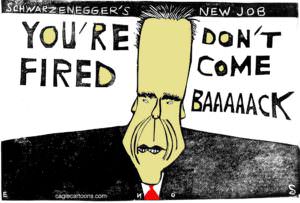Lifting Weights With Otis Chandler
The former publisher of the Los Angeles Times and chairman of Times Mirror, who died on Feb. 27, approached weightlifting with the same kind of passion that animated the other endeavors of his life.
Rick NewcombeEditor’s Note: Otis Chandler, former publisher of the Los Angeles Times and chairman of Times Mirror, died on Feb. 27, 2006, at the age of 78 from a degenerative brain disorder known as Lewy body disease. Memorial services were held on March 6 in Pasadena, Calif.
A quarter-century ago, I pumped iron with Otis Chandler two or three times a week, and I was always impressed by his strength, intelligence, determination, humility and basic decency.
In 1979, I was made a vice president of the Los Angeles Times Syndicate, and one of the perks of the job was access to the executive health center. I was 29, and most of the executives in the gym were in their 40s and 50s. There was only one serious weightlifter, and that was Otis.
The first time I worked out at The Times’ gym, I remember seeing Otis doing squats with 315 pounds, which is an enormous amount of weight for any age, but pretty much unbelievable for a man in his 50s. Picture three manhole covers on each side of an Olympic barbell.
I remember feeling excited and totally relaxed, like a kid at recess. This was in contrast to being button-downed in meetings, wearing our business suits with starched collars.
“Wow! You really are strong,” I said. “Can I give you a spot?”
“Absolutely,” he said. “I think you’re the first person who has asked me that question in this gym.”
A “spot” is a weightlifting term to describe one person helping another to make sure the weights are handled safely and to the maximum ability of the person doing the exercise.
That was the beginning, and we spotted each other many times during the next few years.
Otis noticed that I had lost weight and become a real bodybuilder in the previous year, and he wanted to know how I had made so much progress so quickly. That was very characteristic of him — he had an insatiable curiosity about the world and everything in it.
I told him that I had been a bodybuilder as a teenager and that then, as an adult, I was working with Dr. Franco Columbu, a Mr. Oylmpia who was also a chiropractor in Westwood and Arnold Schwarzenegger’s best friend. Franco was a fantastic personal trainer.
We talked about Arnold many times, and Otis said he admired his entrepreneurial spirit. He also predicted that Arnold would surpass Steve Reeves as a box-office draw. Reeves had played Hercules successfully in the movies.
“I saw Arnold at a dinner for Marvin Davis last night,” Otis said one time when we were relaxing in the jacuzzi after a tough workout. “He has a real presence about him. There’s something about him that is very disarming, very charming.”
I invited Arnold to have lunch in The Times executive dining room and introduced him to some of the paper’s editors and executives. At that time, he had just finished starring in “Conan the Barbarian,” which was his first major movie success.
Otis wanted to know about Franco’s training techniques, so I showed him the routine that Franco had developed to help me strengthen my abdominal muscles. Two weeks later, Otis announced, “I’ve taken two inches off my waist doing that routine!” He said his wife, Bettina, loved it too.
Competition was in his blood, and one day Otis announced that he was entering a masters powerlifting championship. He trained hard doing bench presses, squats and dead lifts, and his total poundages were at a world-class level. But a week before the contest, he pulled a hamstring muscle and had to back out. “This reminds me of hurting my wrist before the Olympics,” he said.
Another time I mentioned that we were starting a health and fitness news service at the syndicate and Joe Weider, the famous bodybuilding magnate, was coming in for lunch.
It was during lunch that Weider told us he was thinking of starting a women’s fitness magazine called Shape. Otis told him to go for it, predicting a big success. As it turned out, that magazine became a cornerstone of the Weider publishing empire that was sold a few years ago for upward of $300 million.
I was struck by how perceptive Otis’ questions were — not about bodybuilding but about the Weider magazines. Otis Chandler was a brilliant businessman, and it is no accident that under his leadership the Los Angeles Times not only improved dramatically in its editorial content but also became a model for business growth.
Otis was goal-oriented and extremely fair. He rewarded performance and eliminated deadwood. He also was smart enough to surround himself with brilliant people such as Publisher Tom Johnson and Editor Bill Thomas.
One time at a newspaper editor convention in Washington, D.C., I saw Otis at a cocktail party. He asked me if I wanted to work out with him the next morning at 6 a.m.
“Sounds great,” I said, “but is it OK if a friend comes along? His name is Shelby Coffey, and he is the features editor at The Washington Post.”
“Yes — that’s terrific,” Otis said. “I’ve heard many good things about Shelby Coffey, and I’ve been meaning to get to know him. So this is perfect, but does he train hard? Are we still going to get a decent workout?”
He was soon to find out that Shelby ran marathons, boxed, lifted weights and trained as intensely as anyone. As you can imagine, the two hit it off — so well, in fact, that Shelby eventually was hired by Times Mirror in Dallas, which led to his being named editor of The Times after Bill Thomas retired a number of years later.
During that workout — and you have to remember that in those days, the weightlifting gyms were dungeons — I remember once when a skinny little runt wanted to see himself exercise in the mirror, which Otis’ considerable frame was blocking.
“Hey, Bud, move!” he said to Otis, in a very belligerent way. Remember, we’re talking about one of the most powerful men in the world.
It was one of those split-second moments that we all have, where I wasn’t sure how to react. Do I punch the kid? Shove him out of the way? Guide Otis and Shelby to another part of the gym? Truth is, I didn’t do any of that. I just froze.
“Oh, I’m sorry — I didn’t mean to block your view,” Otis said. “I know what it’s like when you’re trying to concentrate and someone gets in the way.” And all this was at 6 in the morning!
“It’s no big deal,” the weightlifter said. “I really appreciate your moving.”
And that was that. I just had so much admiration for Otis’ basic civility. He was a true gentleman in all situations.
When I left The Times to work for Rupert Murdoch, Otis called me into his office to offer encouragement and advice. He said he disagreed with Murdoch’s business model for building a successful newspaper but that he admired Rupert as a brilliant businessman.
After I started Creators Syndicate, Otis told me he always had a soft spot for entrepreneurs. He said he had tried to set up The Times, and then Times Mirror, so that the executives felt as if they were operating as entrepreneurs. I told him he had succeeded, and it was one of the reasons I felt prepared to start my own business.
In 1997, I sent Otis a copy of the 1984 Muscle and Fitness article about him that Joe Weider put in his magazine after our luncheon. I told him we were setting up an employee gym at Creators Syndicate, and I had framed the article and put it on the wall for inspiration.
Otis replied in a letter: “I am still working out regularly but the musk-ox hunting accident has taken care of any heavy lifting except for deadlifts and squats.
“I turn 70 this Sunday. Maybe I’ll do some senior competition in lifting.”
He also wrote, “It was good to hear from you again, my friend.”
That was Otis: friendly, competitive, curious, always exploring new worlds and new possibilities, always seeking new challenges. I consider myself very fortunate to have had the opportunity to get to know this giant of a man.
Richard S. Newcombe is the founder of Creators Syndicate, one of the country’s largest editorial syndication firms.
Your support matters…Independent journalism is under threat and overshadowed by heavily funded mainstream media.
You can help level the playing field. Become a member.
Your tax-deductible contribution keeps us digging beneath the headlines to give you thought-provoking, investigative reporting and analysis that unearths what's really happening- without compromise.
Give today to support our courageous, independent journalists.





You need to be a supporter to comment.
There are currently no responses to this article.
Be the first to respond.